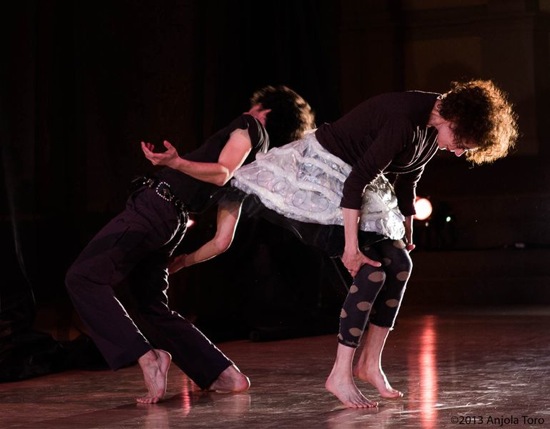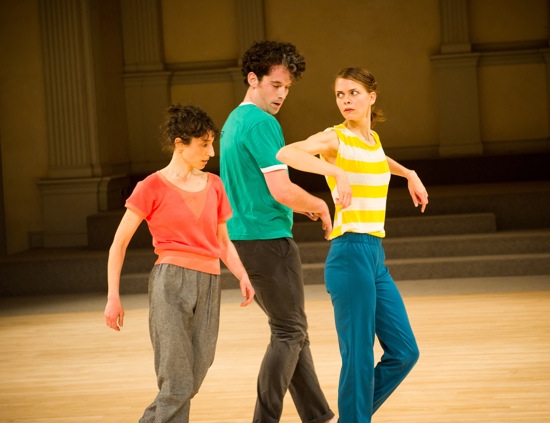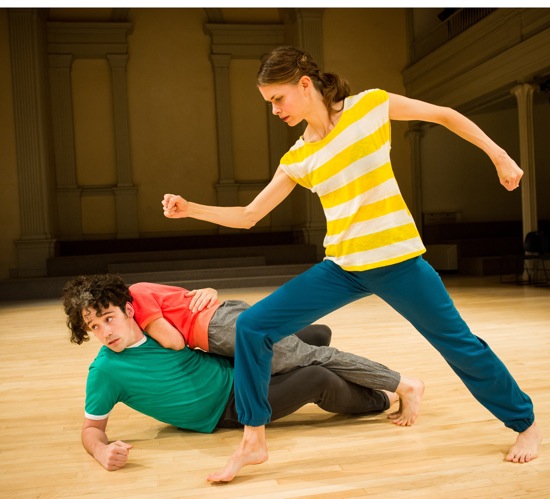Vicky Shick, Doug Elkins, and Joanna Kotze show work in an event-filled January week.
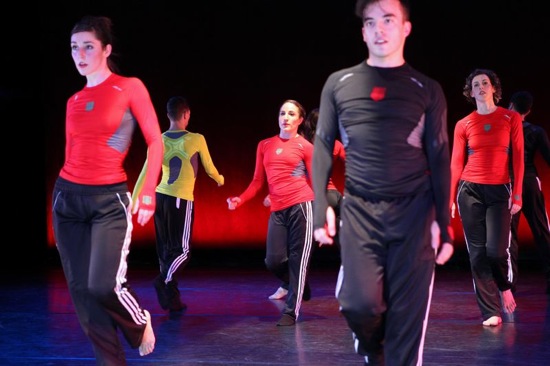
Doug Elkins’s Scott Queen of Marys. L to R:, Cori Marquis, Javier Ninja, Efrat “Bounce” Asherie, Alexander Dones, Donnell Oakley. Photo: Julieta Cervantes
Every January without fail, New York offers a smorgasbord of dance. The Association of Performing Arts Presenters (APAP) convenes in town, and the table is laid for it in every available performing space. The first two weeks of the month are also a time when dancers, choreographers, and dance enthusiasts can catch up with what they missed and sample what they’d like to see more of.
On January 7, the folks who pushed their way into the Joyce Theater (bundled up against the frigid weather and hailing one another with calls of “Happy New Year!”) confronted an unlikely pairing of dances. The third edition of Gotham Arts Exchange’s Focus Dance Festival opened with a program shared by Vicky Shick and Dancers and Doug Elkins Choreography, Etc. Shick’s Everything You See (2013) invites you to watch a colony of gentle, diverse people going about their intriguing business, occasionally meeting up, and always aware of one another. They have tasks to be undertaken and feelings to share. Elkins’s 1994 Scott Queen of Marys is as tautly organized as a parade, and as elegant; everyone involved knows the drill, even though individuals may break away for displays of prowess or humorous engagements with one another. They are very aware of us, the viewers; they almost dare us not to admire them.
Shick’s idiosyncratic movement style is fluid and complex; a movement may set off ripples that pursue quirky paths through a dancer’s body; small gestures punctuate larger, more full-blown dancing. Awkwardness takes on beauty. Elkins, an early-days breakdancer with a postmodern sensibility mingles familiar styles in unusual ways. In this particular dance, traces of highland reels yield to voguing and hip-hop moves, although all his performers clearly have all-purpose dance training. There are plenty of ripples in his movement, but all are precisely designed. As are the floor patterns. He’s a master of, say, three-part counterpoint engineered for maximum clarity and contrast.
I wrote about Shick’s beautiful piece in some detail, when she premiered it at Danspace St. Mark’s last April (https://www.artsjournal.com/dancebeat/2013/04/both-sides-now/). The difference between the earlier performances and those at the Joyce is engendered by the diverse locations, as well as by the exigencies involved in a shared program. In St. Mark’s Church, the audience sat on the two long sides of the space, and the dancers moved on either or both sides of Barbara Kirkpatrick’s “wall” of seven irregular panels of screening. Spectators could see one another through two layers of dancing. On the Joyce’s proscenium stage, a single, subtly draped expanse of scrim divides downstage from upstage, and everyone in the audience has the same perspective; whatever happens behind the scrim, picked out by Carol Mullins’s fine lighting, has that “meanwhile-in-another-room” feel.
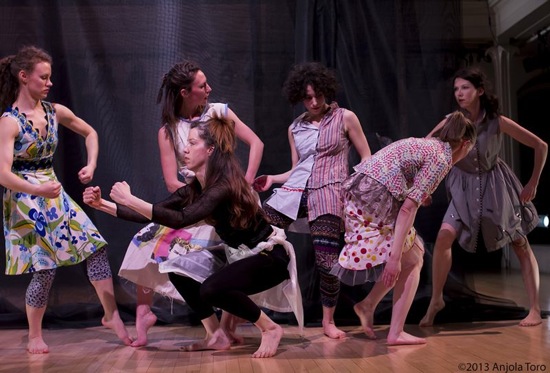
Everything You See. (L to R, back row): Marilyn Maywald, Laurel Tentindo, Lily Gold, Heather Olson. (Front): Donna Costello (L) and Jodi Bender. Photo: Anjola Toro.
Everything You See is so full of interesting happenings that you may note different things each time you see it. At the Joyce, I suddenly catch Jodi Bender and Donna Costello pulling off their blouses and exchanging them, dancing as they go; somewhat later, they’re back in their original attire (also by Kirkpatrick). If at St. Mark’s, Lily Gold upended herself to stand on her forearms for quite a while, I don’t remember it; now it catches my eye. Shick’s use of form is understated. Amid all the peaceful investigations, it’s almost surprising to see Olsi Gjeki and Costello echo the I’ll-just-hold-your-leg-awhile moment that Marilyn Maywald and Heather Olson enjoyed some minutes ago. Watching the piece, I experience all over again the pleasure of watching Jonathan Kinzel and Shick dance thoughtfully, side by side in unison, or Shick and Wendy Perron, resting on the floor, exploring ways of bringing their limbs into contact, or Laurel Tentindo and Gjeki pulling against each other. A slightly different dance. Still beautiful.
Elkins’s Scott Queen of Marys has been through a renovation process. On this tenth anniversary of its first performance on the Joyce stage, the piece has, of course, a new cast—also new lighting by Amanda K. Ringger and new costumes by Naoko Nagata. Mio Morales’s score remains—with its driving beat, occasional distant street voices, raucous jazz, and what cold be distant bagpipes played underwater. I don’t know to what extent the choreography has altered.
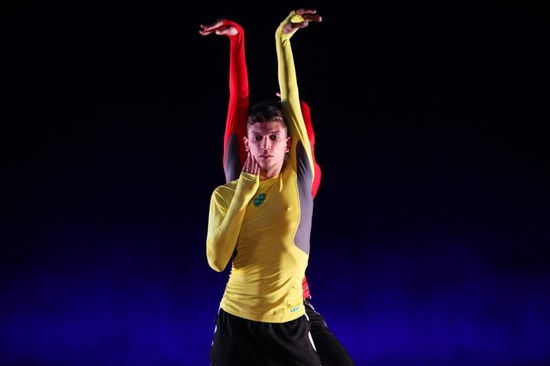
Javier NInja (b. Javier Madrid) in Doug Elkins’ Scott Queen of Marys. Behind him: Donnell Oakley. Photo: Julieta Cervantes
Certainly the cast is more uniform in its skills. You’d have to be super attuned to stylistic quirks to know that although Ephrat “Bounce” Asherie has a background in modern dance and ballet, her turf is breaking, hip-hop, and house, or that Joshua Palmer has performed primarily in contemporary dance performances and in Cherylyn Lavagnino’s ballet choreography.
Elkins’s title itself is a mash-up. Originally dedicated to the memory of Scott MacDowell and Jay Dorff, it references Mary Queen of Scots, her “Marys” (four ladies-in-waiting famed in a ballad of adultery and execution), and Scottish dancing. If there is a “queen” in Elkins’s piece, it’s Javier Ninja (b. Javier Madrid). Like the others, he wears black, side-striped athletic pants, but their form-fitting tops are black or red with mauve patches, while his is mostly yellow. And while the dancers begin in silhouette again a glowing, emerald-green backdrop, snaking their clasped hands through unison patterns, Madrid is the one—the slinky, rubber-jointed master—who, in a virtuosic solo can bring his wreathing arms shockingly far behind his head and snake his slim body uncannily and strut like a fierce-eyed runway model.
Often the dancers, eight in all, enter in pairs, holding hands, their feet busy with springy Highland steps. It’s beguiling how they can, for example, slide from that narrow vertical stance— their arms at their sides—into swinging their hips and shoulders and snaking their arms as they strut along. They acknowledge no discrepancies between forming into two lines for a seconds-long reel and dropping low for a breakdance spin. Kyle Marshall, Asherie, Kellie Ann Lynch, and Donnell Oakley engage in clambering and twisting over and around one another in a business-like manner, but there’s more than a hint of voguing competition when Madrid and Palmer strut their stuff, eyeing each other, as well as us. The audience applauds a smart face-off between Madrid and the taller Marshall. All the performers (that includes Alexander Dones and Cori Marquis) move expertly through the terrific array of patterns and upsets that Elkins has so ingenuously designed.
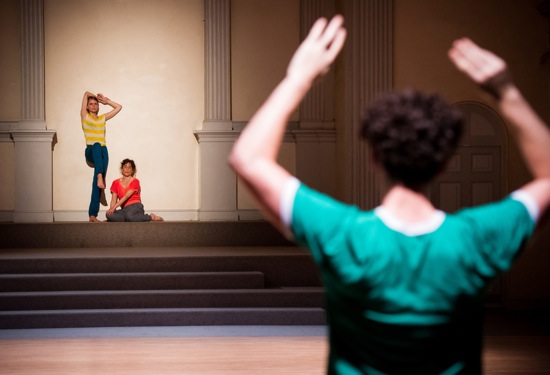
Joanna Kotze’s IT HAD HAPPENED, IT HAPPENED, IT IS HAPPENING, IT WILL HAPPEN. Foreground: Stuart Singer. At back: Kotze (L) and Netta Yerushalmy. Photo: Ian Douglas
Elkins breaches the fourth wall at the Joyce by his performers’ challenging gaze toward the audience. Downtown at St. Mark’s Church, Joanna Kotze in her IT HAD HAPPENED, IT HAPPENED, IT IS HAPPENING IT WILL HAPPEN breaches it by proximity, or by introducing the possibility that the performers may touch you—yes, you, sitting in the front row. On January 10 and 11 during APAP, Kotze repeated the work that premiered at Danspace Project St. Mark’s at the end of last May and won her a “Bessie” Award for Outstanding Emerging Choreographer.
Kotze, familiar to New York audiences for her dancing in works by Wally Cardona, Kimberley Bartosik, Netta Yerushalmy and others, has a BA in architecture and credits the late Georges Perec’s fascinating and daring book Species of Spaces and Other Pieces as an influence on IT HAD HAPPENED. . . . The church, laden with past history and future possibilities, becomes transformed by movement, sounds, and light. The audience sits in single rows of chairs on three sides of the space, with other spectators finding seating on the carpeting platforms behind the rows or on the floor at one end of the nave. Kotze—tall, slim, and leggy— begins affirming rectangularity by pacing the perimeter of the performing area. She’s doing this even while Abby Harris Holmes of Danspace is introducing the evening, pointing out the exits, and telling us to turn off our cell phones.
Unless you’d read interviews and publicity material, you mightn’t know that one of Kotze’s focuses in making this trio for herself, Netta Yerushalmy, and Stuart Singer (all wonderfully individual performers) was to bring past, present, and future into seamless proximity. You do, however, sense in the performers’ attitudes hints of remembering and planning ahead, and the unexpected, seemingly unmotivated variety of their activities affirms that Koyze has groomed the vagaries of thought into artful formality.
In her opening solo, Kotze often appears pensive, a little scared. Sometimes she gazes upward, as if expecting something to fall, but when she slows her forceful stride, she looks hard at us, comes very close to us, touches a man’s leg. The spatial and rhythmic variety of her dancing is expansive. A mini-burst into a little side leap sets her off springing on paths around the space. She also plants herself into a position wide-legged enough to become a splits and scrabbles on the floor with her hands. She walks along an invisible trail on prissy tiptoe, pauses for breath, crawls, marches, peels off a shirt (clothing by Reid Bartelme), strikes an arabesque and rotates slowly in that position, then goes briefly limp and exits. All in relative silence.
Her thoughtful air is set in relief by Singer’s ensuing solo. He enters like a whirlwind—fast and strong—racing here and there. He’s solidly built and muscular, yet there’s a plushy softness to his dancing. His moves are precise, but his arms and hands create little flourishes, as if echoing the gestures of Baroque court dance. When Kotze and Yerushalmy join him in a lineup, all three assert their individuality in simultaneous solos, while smacking themselves vigorously and gradually moving toward the front of the church. The sounds they make echo in the vaulted church.
As the dance progresses, the three dancers move and interact (or not) in ingenious, thought-provoking ways. Enigmas abound. Why does Yerushalmy over and over again run at Singer, who stops his own small maneuvers to catch her as she leaps, lift her high, and set her down again? (Accept the fleeting traces of narrative if you like.) When Kotze gets the resting Stuart to his feet, he grabs her under her arms and spins with her. Watchful, Yerushalmy—smaller than Kotze and calmer, earthy yet uncannily fluid—stands to the side and wheels her arms around and around. Two kinds of circles then, but somehow more than that. . . . Later Stuart lies on top of Yerushalmy, both of them supine, as if she were a comfortable-enough bed.
These people connect in intriguing ways, puzzling out where to put their limbs, where to touch one another. Sometimes their dancing is fast and furious, yet Yerushalmy sits alone for a long time on the altar platform, leaning against its wall, while Kathy Kauffman dims the lighting very, very, very gradually. Sometime there is sound from elsewhere (by Dave Ruder): distant ticking, crackling, what might be a train. The space alters mysteriously. The dancers’ stamping and finger-snapping test its atmosphere. I’m always finding out new things about these people and this place, surprised by what they decide to do next or what has just filtered from their memories into behavior. What happened? For sure, a little marvel of a dance.

